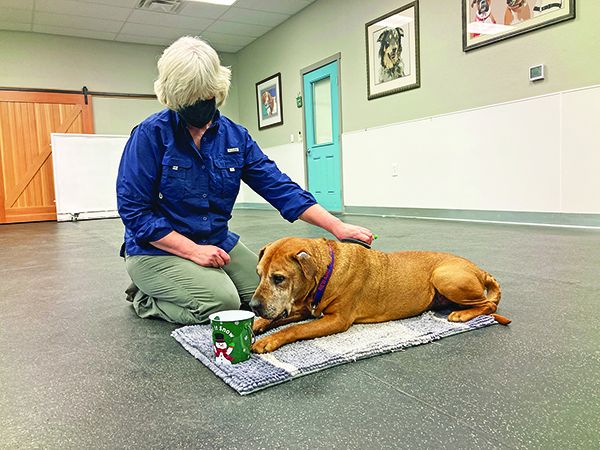
My wonderful Scottie/Corgi/Poodle-mix, Bonnie, had long, fine, curly fur that tangled easily. She was relatively tolerant of my frequent insistence on combing out the tangles, except when it came to her hindquarters. When I would try to brush her there, she tensed up and sometimes even growled.
Then she learned the Bucket Game, and as a result of her learning a new way to communicate her feelings to me about being groomed – one that didn’t require the escalation of aggressive behaviors – her attitude during grooming went from tolerance to complete relaxation and enjoyment. She was a classic study in the behavioral value of giving our dogs choice and control in their world through cooperative care.
Cooperative care involves training an animal to not only tolerate handling and husbandry procedures, but also to be an active, willing participant in these experiences.
EVOLUTION OF A MOVEMENT
There is a long overdue and growing awareness in the dog-care professions of the importance of engaging our canine companions’ cooperation and giving them some control over the various husbandry procedures we ask them to endure. For far too long the attitude in the dog world has been, “You have to do it because I said so.”
Force-free dog training emerged as a movement more than two decades ago and continues to grow in popularity and availability. Some segments of the dog world – groomers, shelter staff, and veterinary hospital workers – were slower to embrace cooperative care, but this is now changing rapidly.
In 2016, “America’s veterinarian,” Marty Becker, DVM, launched Fear Free, an educational curriculum and certification program that teaches veterinary professionals to handle and treat their patients without scaring them.
Today, Fear Free offers educational opportunities and certification for dog trainers and groomers, with plans to add dog walkers, pet sitters, and more in the near future. The organization also makes Fear Free information available at no cost to pet owners and shelter workers.
In addition, the American Animal Hospital Association is nearing completion on a comprehensive book on cooperative care for veterinary practices, planned for a late spring release. And Deborah Jones, Ph.D., the author of Cooperative Care: Seven Steps to Stress-Free Husbandry (2018), offers an online Cooperative Care Certificate course.
All dog owners need to perform basic husbandry tasks on their dogs at some point – pull burrs out of the dog’s coat, examine and clean a wound, administer eye drops, clean ears, brush teeth, and so on. To gain their dogs’ willing participation in these tasks, Jones recommends that, first, dog owners teach their dogs some basic behaviors for cooperative care – skills that will ease your way through almost any dog-care procedures that owners are likely to face. She teaches these essential skills in a specific order, so the dog learns them in a systematic and progressive way. Jones’ “10 Essentials” for cooperative care are:
1) Chin Rest (or Bucket Game)
2) Lie on Side
3) Restraint
4) Wear a Muzzle
5) Foot Handling
6) Mouth Handling
7) Taking Medication
8) Injection or Blood Draw
9) Eye Exam
10) Ear Exam
THE BUCKET GAME – A GAME OF CHOICE
There are a variety of protocols that can help your dog learn to enjoy these procedures. The Bucket Game is one of the most inventive and versatile. The Bucket Game was developed and introduced to the dog training world by trainer Chirag Patel, owner of Domesticated Manners, a training business in London. Once taught, the Bucket Game can be used for several of the 10 essential behaviors, as well as for everyday husbandry procedures such as grooming and nail trimming.
This fun and easy dog-training protocol empowers the learner, by creating an environment where your dog has choice and can communicate her willingness to participate. Using the Bucket Game, your dog can tell you:
• When she is ready to start
• When she needs to take a break
• When she wants to stop
• When you need to slow down
All you need to play the Bucket Game is a little bucket or some other container to hold treats and a lot of small, high-value treats.
STEP 1: TEACHING IMPULSE CONTROL IN THE PRESENCE OF THE BUCKET
1. Start by holding the bucket out to your side. Reward your dog (feed a treat from the bucket) for looking at the bucket but maintaining some distance from it (two to four feet).
Usually, once your dog has seen you reach into the bucket, take out a yummy treat, and feed it to her, she’ll look at the bucket again, wondering what it’s all about. Be ready! When you see her glance at it, take a treat out of it and give her one. You’re on your way. Repeat a number of times.
If your dog tries to jump up or dive into the bucket, don’t admonish her; just hold it higher. It shouldn’t take long for her to realize that the best way to get more treats is to keep returning her gaze to the bucket without trying to jump up and help herself to them.
2. Put the bucket on the ground, a chair, or a table, and reward the dog (feed a treat from the bucket) for looking at it but not trying to get it. Your dog can be in any position; you are simply rewarding her for looking at the bucket. Repeat several times.
3. Gradually begin increasing the duration of her gaze, by rewarding her with treats from the bucket for looking at it for longer and longer periods. Don’t wait too long, increasing the duration too much, too quickly, as this may cause the behavior to extinguish.
Remember, this is a game of choice; your dog is allowed to look around between focusing on the bucket. Don’t call her, tap on the bucket, or do anything else to draw her attention to it. Let your dog choose to engage to participate.
STEP 2: INTRODUCING THE CONCEPT OF CHOICE
1. Practice until your dog is able to focus on the bucket for a duration of at least 10 seconds. Remember that it doesn’t matter what position she’s in; it could be a sit, down, or stand.
2. Choose what procedure you want to introduce to your dog as part of the Bucket Game, such as being groomed or looking in her ears. I’ll describe the steps as if we were working on brushing the dog.
3. When she is focused on the bucket and able to hold her focus for at least 10 seconds, start moving your hand toward her side (not touching her). If she continues to look at the bucket, stop moving your hand toward her and feed her a treat from the bucket. If she looks away from the bucket, probably to look at your hand or face (“What are you doing?”), just draw your hand back.
Remember, this is a game of choice. She may not yet understand that she can communicate to you that she is uncomfortable – she may have just been curious, but she will come to understand as you continue the process.
4. When she re-engages with the bucket, the game begins again. This time, don’t move your hand so fast or far. If she is able to maintain focus on the bucket, reward her with a treat from the bucket.
Repeat this process with your hand moving toward her, closer and closer, giving her a treat every so often as long as she continues to gaze at the bucket, and withdrawing your hand if she looks away from the bucket.
5. Eventually, you should be able to touch her as she gazes at the bucket. The first time you make contact with her, she will likely look at you. Just withdraw your hand, and try again after she gazes at the bucket again. She should be starting to figure out that the only way to get treats is to keep gazing at the bucket, no matter what you do with your hand. Touch her with increasing pressure at various locations on her body where you will be grooming her, rewarding her every so often. Again, don’t wait so long that she starts to think it’s not worth playing the game, but she should be able to hold her gaze on the bucket for at least 10 or 15 seconds while you touch her.
6. Now pick up her brush and repeat Step 3, this time with the brush in your hand. After several repetitions with the brush held near her, start touching her with the brush. This continues until you are able to groom your dog with her looking at the bucket.
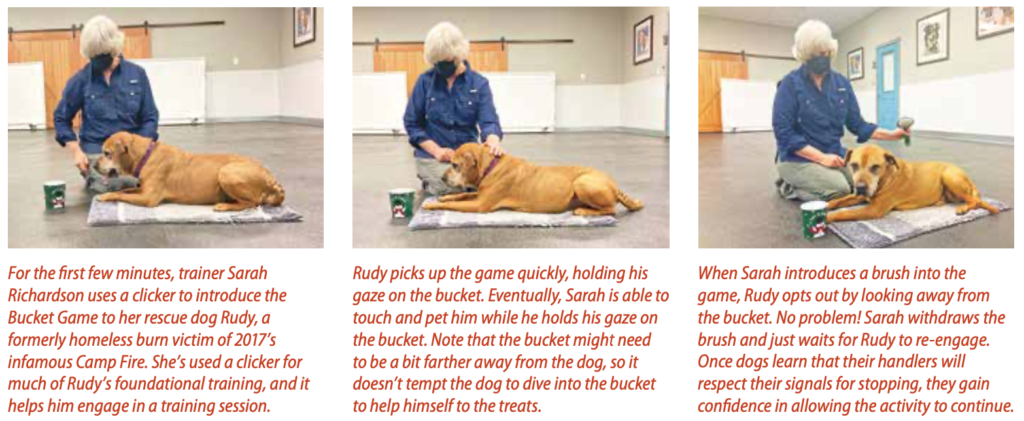
THE MOST IMPORTANT RULE OF THE GAME
When your dog has learned the game for one procedure, you can easily generalize it to others, including ear and mouth exams, foot handling, nail trimming, etc.
However, this game of choice will only work if you allow your dog to communicate that she wishes to begin, take a break, and stop the game. If your dog looks away from the bucket, stop the game. When she re-engages with the bucket, the game continues. It’s imperative that you honor her request to stop and only use the procedure when you are able to honor her request to stop.
If you use the Bucket Game while working with other animal-care professionals, they also must be willing to stop any procedure when your dog looks away from the bucket. If they are not willing to do so, don’t use the Bucket Game with them. If they are doing a procedure that cannot be stopped once it has started, don’t use the Bucket Game with that procedure.
Below, you’ll find some links for videos on YouTube of a trainer teaching her dog some of these cooperative care exercises. Lauren Novack is an Associate Certified Dog Behavior Consultant, Karen Pryor Academy Certified Training Partner, and Family Paws Parent Educator who is also certified in Pet First Aid and CPR. She works as a Behavior Consultant at Behavior Vets in New York City. She is also an MS Candidate in Applied Behavior Analysis at Hunter College.
In the videos, Novack can be seen training her mixed-breed dog Grayson to sit or stand still for examinations, grooming, and administering vaccinations or other injections. He’s completely unrestrained and performing these useful behavior, as Novack says, like any other trick he’s been taught.
Novack is offering a three-part webinar series on Applied Behavior Analysis for professionals in animal-care or -training fields. The series starts on January 23. For more information about different technologies for gathering information and creating plans that will alleviate animal suffering, click here.
“Chin rest” cooperative care/husbandry exercise being taught by behavior consultant Lauren Novack
Behavior consultant Lauren Novack teaching a dog to “station” for cooperative husbandry tasks.
Cooperative care: Behavior consultant Lauren Novack gives a dog a needle poke without any restraint
Cooperative care at its finest: Behavior consultant Lauren Novack’s dog Grayson receives a vaccine
1996: Publication of The Culture Clash by Jean Donaldson.
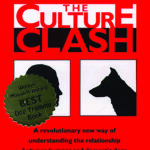 A refreshing new perspective on the relationship between people and dogs has redefined the state of the art of dog-friendly dog training. Available wherever books are sold
A refreshing new perspective on the relationship between people and dogs has redefined the state of the art of dog-friendly dog training. Available wherever books are sold
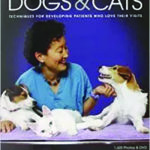
2009: Publication of Low Stress Handling of Dogs and Cats by Sophia Yin, DVM. With more than 1,600 photos and 3 hours of video, this book and companion DVD offers tips, tools, and techniques for recognizing brewing fear and aggression, while reducing this through specific handling techniques that decrease stress and improve patient comfort and safety. See lowstresshandling.com
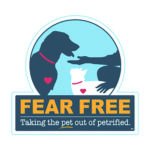
2016: Marty Becker, DVM, launches Fear Free. Their mission is to prevent and alleviate fear, anxiety, and stress in pets by inspiring and educating the people who care for them. See fearfreepets.com
2018: Publication of Cooperative Care: Seven Steps to Stress-Free Husbandry by Deborah Jones, Ph.D. From the book: “When we take the time to carefully observe our dog’s behavior, read their stress signals, and respect their communication with us, it’s just amazing how quickly we can replace suspicion with trust. Our goal is to empower our dogs and help them gain confidence in the husbandry process.” Available wherever books are sold
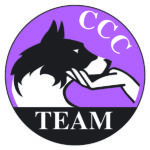
2020: Cooperative Care Certificate course launched by Deborah Jones, Ph.D. One of the absolute best things you can do for your dog is to help make the care necessary for his health and well-being as stress-free and familiar as possible. This course provides a virtual titling program that will help you organize and assess your dog’s readiness and comfort for grooming procedures and veterinary care. See cooperativecarecertificate.com
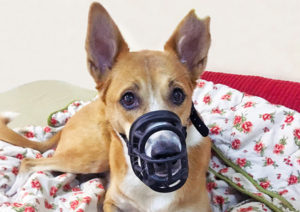
• “Touch Me, Touch Me Not,” August 2004. What to do when your dog hates being touched: A program for making your dog safer to live with and easier to examine.
• “Safe and Not Sorry,” August 2009. Why and how to condition your dog to comfortably and happily wear a muzzle.
• “Positive Pedi-Pedi’s,” August 2012. Force-free nail-trimming techniques:
Three alternative procedures to try on your dog.
• “Touching Moments,” March 2014. How to properly examine your dog: Teach your dog to not just accept but also enjoy handling, examinations, and even restraint.
• “Nuzzle Up To Muzzles,” February 2019. Why, when, and how every dog should learn to wear a muzzle.
• “Learning to Love It,” October 2020. A counter-conditioning protocol for nail trimming.
It is critically important to your dog’s welfare and quality of life that you work with only those dog-industry professionals who will follow your wishes concerning your dog’s care and handling in all interactions. It makes absolutely no sense to spend years building your dog’s trust in humans and then turn him over to a veterinary technician who alpha-rolls him in an exam room or drags him into a treatment room as he shrieks in fear. Getting choked into compliance by a groomer, shocked by a trainer, yanked or struck by a dog-walker – any of these experiences can cause irreparable harm to his trust of and interest in humans.
It took some time to find a veterinarian who understands and respects that my dogs and cats don’t ever get taken to “the back” for routine procedures. I’m fortunate and grateful: Even during this pandemic, my clinic allows one human to come into the clinic with their animal companion.
How do you find professionals who understand and follow a cooperative care/fear-free/force-free philosophy? You can find various lists or directories for finding such professionals, and we’ve listed a few of these below. But no matter what list or directory you use, once you have contacted an individual, we recommend that you scrutinize them further. Interview them, ask for references, observe them at work to ensure that they practice what they preach, and be prepared to step in and halt procedures at any time if you don’t like what you see.
Fear Free Pets: Veterinarians, trainers, groomers, and coming soon – dog walkers and dog sitters. fearfreepets.com/fear-free-pet-professionals/
Pet Professional Guild: All members are committed to force-free training and handling methods. petprofessionalguild.com/Zip-Code-Search
Pat Miller Certified Trainers: These are trainers who have successfully completed at least three of Pat Miller’s academies and are committed to using force-free training and handling methods. peaceablepaws.com/pat-miller-certified-trainers/
Academy for Dog Trainers: Jean Donaldson’s Academy exists to provide a comprehensive, science-based curriculum on aversive-free pet dog training, behavior and behavior modification. academyfordogtrainers.com/find-a-trainer/
Victoria Stillwell Academy Certified Dog Trainer: This academy gives students the knowledge and skill to assemble a comprehensive “trainer tool kit” as well as the confidence to be able to clearly explain to clients why positive training is the only recommended philosophy when using these various tools. vsdogtrainingacademy.com/become-dog-trainer/dog-trainer-certification/
Karen Pryor Academy Certified Training Partners: The Karen Pryor Academy teaches students to be skilled trainers and effective teachers using positive reinforcement training. karenpryoracademy.com/find-a-trainer/#!directory/map
Other Organizations: While the following organizations follow the “least intrusive, minimally aversive” (LIMA) principle, their members and/or certificants do not necessarily strictly adhere to that code – do your research!
Association of Professional Dog Trainers: locateatrainer.org
Certification Council for Professional Dog Trainers: ccpdt.org/dog-owners/certified-dog-trainer-directory/
International Association of Animal Behavior Consultants: m.iaabc.org/consultant/




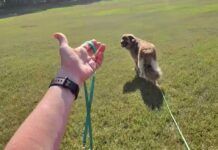

Hi there what you recommend to training my dig.
I am seeing cooperative care being suggested in lue of standard puppy gentling, in the industry. I don’t think cooperative care is meant to replace standard puppy gentling and worry about the dire consequences of only handling young puppies with consent instead of teaching them that humans handling them is a positive experience. It seems using cooperative care for puppy gentling will leave puppies unprepared for standard handling, and will lead to aggressive defensive adolescent dogs. (Working with one now that had cooperative care used for puppy handling… and he is indeed biting for pretty typical non-invasive handling.) I am hoping one of the core trainers in the industry will look at this issue and weigh in (before we get a bunch of biting teen pups… when we could have avoided such with standard gentling practices.) I would love to hear your thoughts!